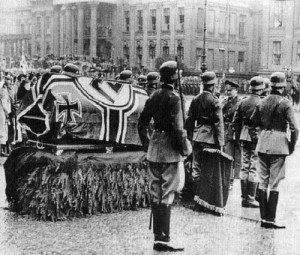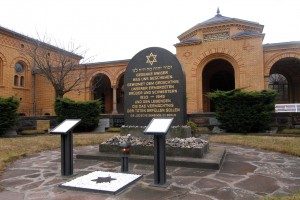In Chapter 12 of Berlin at War, Moorhouse touches upon the differences in burials between those taking place at Berlin’s Invaliden cemetery and those taking place at Weissensee. Invaliden became a burial ground for prominent members of the military, whereas Weissensee “became a last refuge for the desperate” (262).
In Invaliden, angels and eagles predominated. As WWII began, some important military members would be killed during the course of the war. One such general was Werner von Fritsch. He was killed in the Polish campaign outside of Warsaw. The Nazis held an elaborate funeral, with the coffin covered with the swastika flag. The general’s steel helmet and dagger were also recovered.

A few more important military members would be buried in the same cemetery. Luftwaffe general Ernst Udet, who committed suicide, was honored due to his high scoring surviving air ace during the First World War. Even though important military members did not die often during the war, death was still always occurring. It was rare to find a family in tact during the war years. Regular citizens rarely received a formal burial, whereas important military veterans received a highly celebrated funeral. Nonetheless, death occurred in extremely high numbers during the war, whether it was directly on the warfront or it came from bombings and city life.
Berlin consisted of many Jewish cemeteries before the outbreak of WWII. However, only one remained, which happened to be both the largest and most prominent: Weissensee. This cemetery was founded in the late nineteenth century and has more than 100,000 graves over 40 hectares of land. Weissensee was associated with the more “Germanic” Jewish people, who also did not lose any sight of their religion.

Both Invaliden and Weissensee had a few similarities. Both contained the best and brightest people of the times. Both stood as testament to communities at the apex of their power and influence. The Jewish cemetery soon became overgrown due to its immense size. It also became a hiding place for Jews who decided to go underground.
Death was ever-present during the 1940s throughout Europe. German citizens had to deal with air attack on almost a nightly basis. They also had to deal with criminals, such as the S-Bahn murderer. The German military was also facing death as a result of fighting a two-front war for a few years. As a result, there was not always time for a proper burial to take place and those fighting for the Fuhrer would simply lie where they fell.

These are great images–and the ones you obtained of the radio.
I wonder if the Jewish cemetery still exists…
I must say, I was very unpleasantly surprised by how the death of soldiers was handled during this time. While I have never had a loved one in the military, and I am not very familiar with the notification process, I would have thought the process would involve more empathy. In movies, you typically see an officer go to the home of the fallen to personal inform the families, and from what I could find, that s typically the case. The reasons for the emotionless “letters” were due to lack of technology and transportation, I think. I also thought that the intensity of the Nazi party could be responsible for the discrepancy, as caring for the closure and well-being of families of deceased soldiers would not seem to be a top priority. Here is the link to a letter to an American family about a fallen American soldier.
http://www.arlingtoncemetery.net/hgjohns-war-department-letter-of-notification-photo-01.jpg
This letter seems very similar to what the Germans used during this time. I guess I am just confused by this type of response. You would think the true attitudes of complete patriotism and dedication to one’s country would include taking the upmost care of the ones fighting for it, and to provide complete honor to them. You would think thy would at least get a proper burial and ceremony?
The Jewish cemetery actually does still exist! The Weissensee Cemetery was reopened and serves a memorial to those lives lost in the Holocaust. In addition to the graves of those in the cemetery, there is a memorial plaque in honor of the men, women, and children murdered in the camps who did not have a grave due to the fact that their ashes were released all over the site.
Also, Ken, on your whole note about what happened post-death with a lot of the people, there is a section of the cemetery that has approximately 300 urns full of ashes of people who fell victim to the cruelties of this time. The concentration camp administrators actually used to send the ashes of victims to the victims’ families!
fun fact: tomorrow, May 11, makes exactly 60 years since Martin Riesenburger (man who hid in the cemetery with his wife during the Holocaust and later became a Rabbi) held the first post-war prayer service to take place at this site!